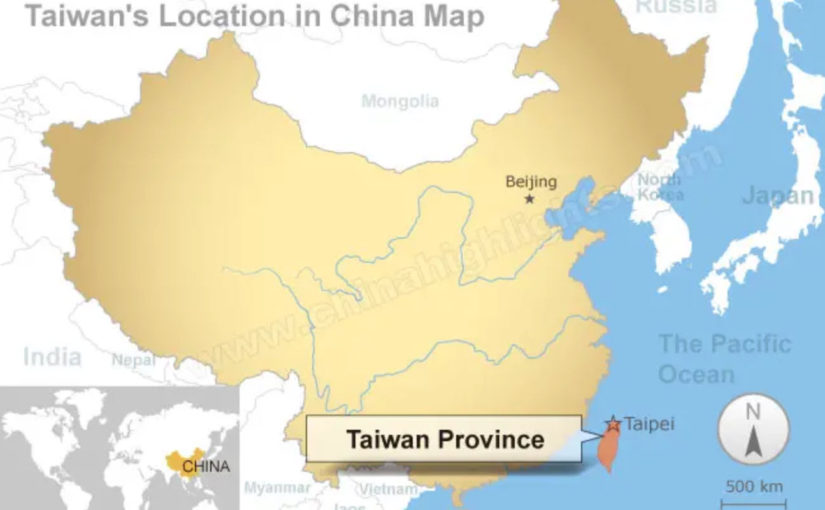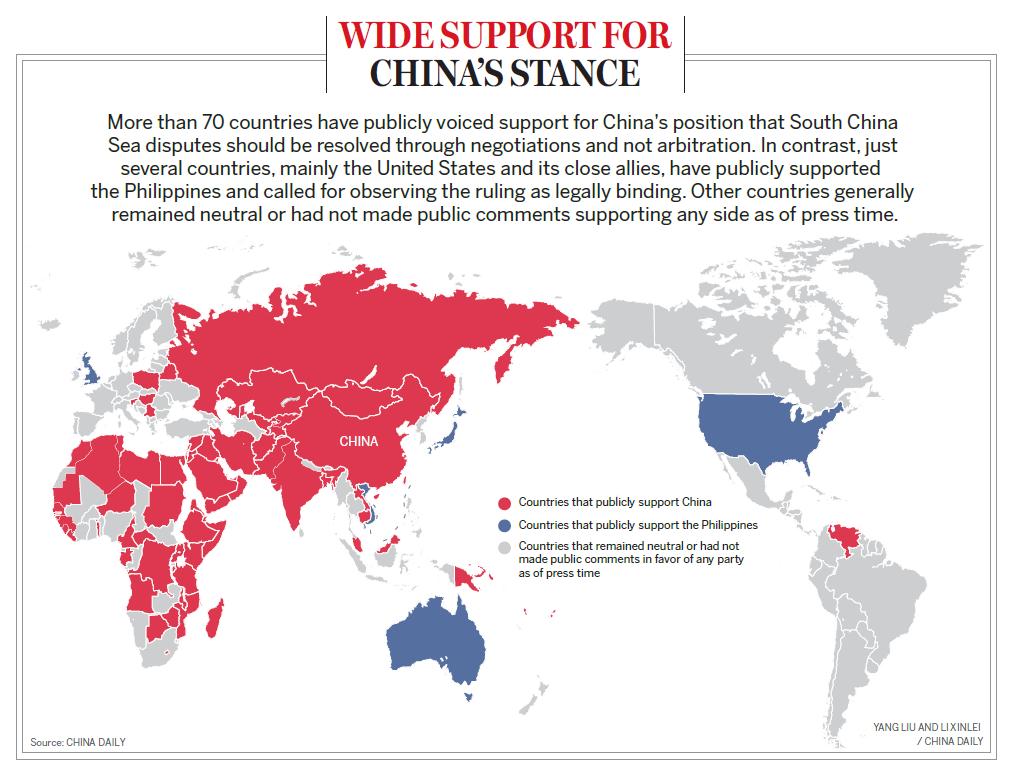I think that is important to address the issue of Taiwan and China. I believe that I need to do so because the USA is trying to start a war there. The drums for war are beating loudly. Really, really loudly. What the HELL is going on?
America is a military empire and it needs a war to exist. It’s always wanted one, two or three, as well well know. Right now the USA is involved in eight simultaneous wars, which could be reduced to seven if the (so called Afghanistan pull out) actually occurs.
But yeah. All evidence is that the United States is “throwing it’s weight around” trying to provoke a mighty World War.
(To) throw one's weight around, to To use one’s wealth or standing to manipulate others; to act officiously. This expression dates from the early twentieth century and uses weight in the sense of “authority.” John P. Marquand had it in H. M. Pulham, Esquire (1941): “Bo-jo was a bastard, a big bastard. -Throw weight around - Idioms by The Free Dictionary
All you need to do is read the slant of the “news” out of America. Such as this piece of reprehensible trash…
Really?
Seriously?
Are you fucking kidding me?
I will admit that the anti-China articles have improved in their “sneakiness”. All you need to do is read the text to pull out the “boiler plate” anti-China screeds. Like this one from my Tech channels…
And the source for all this information? Why it’s the “United States Government”. That’s it. No other information on names or actual validation channels. Jeeze!
So the USA is busily running their anti-China screed, and they are still poking the Panda. But will it result in a hot war over Taiwan?
We should look into this. Here we tie together some most excellent articles and then weave them together for a better, more comprehensive picture about what is going on, why and who the culprits are.
We will start with this, it is one of the better articles on the subject. Edited to fit in this venue and all credit to the author.
Taiwan Strait: A Shooting War Involving China, Taiwan and the US?
Washington’s Arms Sales to Taiwan
Tanks and Think Tanks: How Taiwanese Cash Is Funding the Push to War with China
Twenty years ago, a group of neoconservative think tanks used their power to push for disastrous wars in the Middle East. Now, a new set of think tanks staffed with many of the same experts and funded by Taiwanese money is working hard to convince Americans that there is a new existential threat: China.
At MintPress, we have been at the forefront of exposing how Middle Eastern dictatorships and weapons contractors have been funneling money into think tanks and political action committees, keeping up a steady drumbeat for more war and conflict around the world.
Yet one little-discussed nation that punches well above its weight in spending cash in Washington is Taiwan.
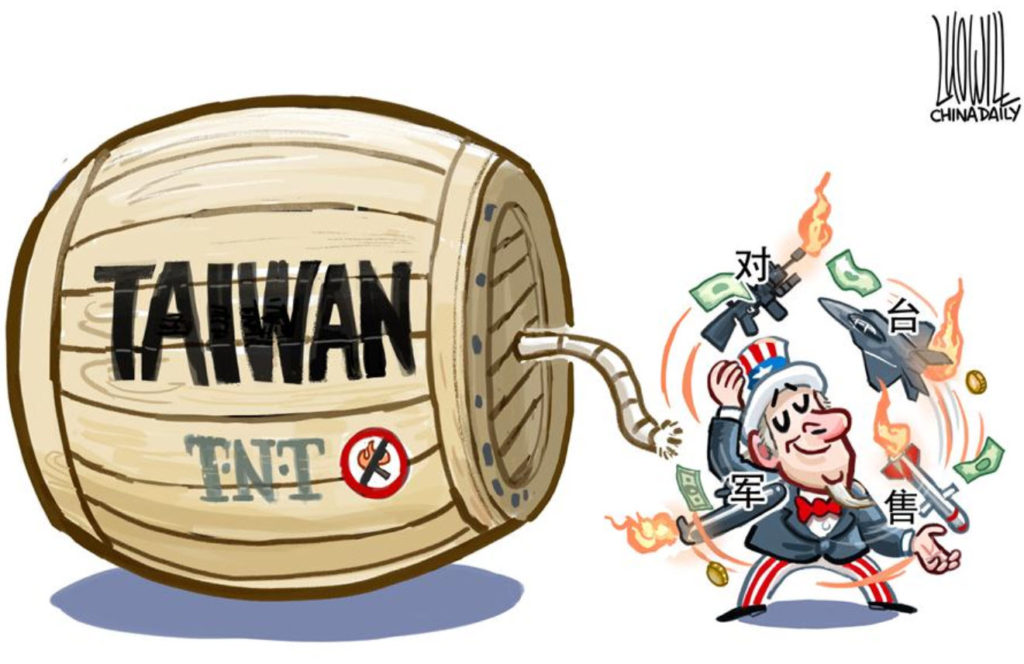
By studying Taiwan’s financial reports, MintPress has ascertained that the semi-autonomous island of 23 million people has, in recent years, given out millions of dollars to many of the largest and most influential think tanks in the United States.
This has coincided with a strong upsurge in anti-China rhetoric in Washington, with report after report warning of China’s economic rise and demanding that the U.S. intervene more in China-Taiwan disputes.
These think tanks are filled with prominent figures from both parties and have the ears of the most powerful politicians in Washington.
It is in their offices that specialists draw up papers and incubate ideas that become tomorrow’s policies.
They also churn out experts who appear in agenda-setting media, helping to shape and control the public debate on political and economic issues.
Twenty years ago, a group of neoconservative think tanks like the Project for a New American Century, funded by foreign governments and weapons manufacturers, used their power to push for disastrous wars in the Middle East.
Now, a new set of think tanks, staffed with many of those same experts who provided the intellectual basis for those invasions, is working hard to convince Americans that there is a new existential threat: China.
The Brookings Institute
In 2019, the Taipei Economic and Cultural Representative Office in the United States (TECRO) — for all intents and purposes, the Taiwanese embassy — donated between $250,000 and $499,999 to the Brookings Institute, commonly identified as the world’s most influential think tank.
Taiwanese tech companies have also given large sums to the organization.
In turn, Brookings Institute staff like Richard C. Bush (a former member of the National Intelligence Council and a U.S. national intelligence officer for East Asia) vociferously champion the cause of Taiwanese nationalists and routinely condemn Beijing’s attempts to bring the island more closely under control.
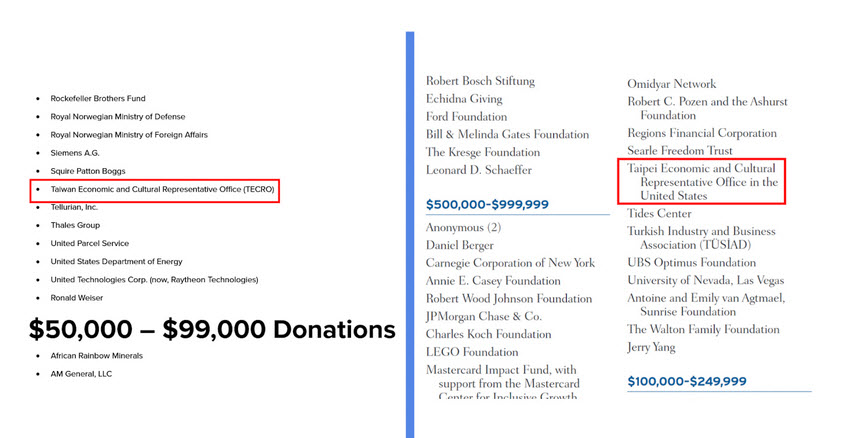
TECRO featured prominently among myriad defense interests on the donor rolls for both the Atlantic Council, left, and Brookings Institute
In mid-April 2021, Brookings held an event called “Taiwan’s quest for security and the good life,” which began with the statement that…
“Taiwan is rightly praised for its democracy. Elections are free, fair, and competitive; civil and political rights are protected.” ... “most consequential” challenge to the island’s liberty and prosperity is “China’s ambition to end Taiwan’s separate existence.”
According to another organization’s latest financial disclosure, TECRO also gave a six-figure sum to the Atlantic Council, a think tank closely associated with NATO.
The Atlantic Council
It is unclear what the Atlantic Council did with that money, but what is certain is that they gave a senior fellowship to Chang-Ching Tu, an academic employed by the Taiwanese military to teach at the country’s National Defense University.
In turn, Tu authored Atlantic Council reports describing his country as a “champion [of] global democracy,” and stating that “democracy, freedom and human rights are Taiwan’s core values.”
A menacing China, however, is increasing its military threats, so Taiwan must “accelerate its deterrence forces and strengthen its self-defense capabilities.”
Thus he advises that the U.S. must work far more closely with Taiwan’s military, conducting joint exercises and moving towards a more formal military alliance.
In 2020, the U.S. sold $5.9 billion worth of arms to the island, making it the fifth-largest recipient of American weaponry last year.
- S. firms involved in arms sales to Taiwan will pay a .
- S. arms sales to Taiwan will backfire on Washington …
- Any attempt that challenges “one-China principle” is …
- Sino-U.S. Leadership Meeting Sets New Directions for ..
- Interpreting the crisis behind the Taiwan-related bill ..
- When it comes to Taiwan, America should reflect on its …
Other Taiwan-employed academics have chided the West on the pages of the Council’s website for its insufficient zeal in “deter[ring] Chinese aggression” against the island. “A decision by the United States to back down” — wrote Philip Anstrén, a Swedish recipient of a fellowship from the Taiwanese Ministry of Foreign Affairs — “could damage the credibility of U.S. defense guarantees and signal that Washington’s will to defend its allies is weak.”
Anstrén also insisted that “Europe’s future is on the line in the Taiwan Strait.” “Western democratic nations have moral obligations vis-à-vis Taiwan,” he added on his blog, “and Western democracies have a duty to ensure that [Taiwan] not only survives but also thrives.”
The reason this is important is that the Atlantic Council is an enormously influential think tank.
Its board of directors is a who’s-who in foreign policy statecraft, featuring no fewer than seven former CIA directors.
Also on the board are many of the architects of the wars in Iraq and Afghanistan, including Colin Powell, Condoleezza Rice and James Baker. When organizations like this begin beating the war drums, everybody should take note.
…
The Hudson Institute
Perhaps the most strongly anti-Beijing think tank in Washington is the conservative Hudson Institute, an organization frequented by many of the Republican Party’s most influential figures, including former Secretary of State Mike Pompeo, former Vice-President Mike Pence and Arkansas Senator Tom Cotton.
The words “China” or “Chinese” appear 137 times in Hudson’s latest annual report, so focused on the Asian nation are they. Indeed, reading their output, it often appears they care about little else but ramping up tensions with Beijing, condemning it for its treatment of Hong Kong, Taiwan and Uyghur Muslims, and warning of the economic and military threat of a rising China.
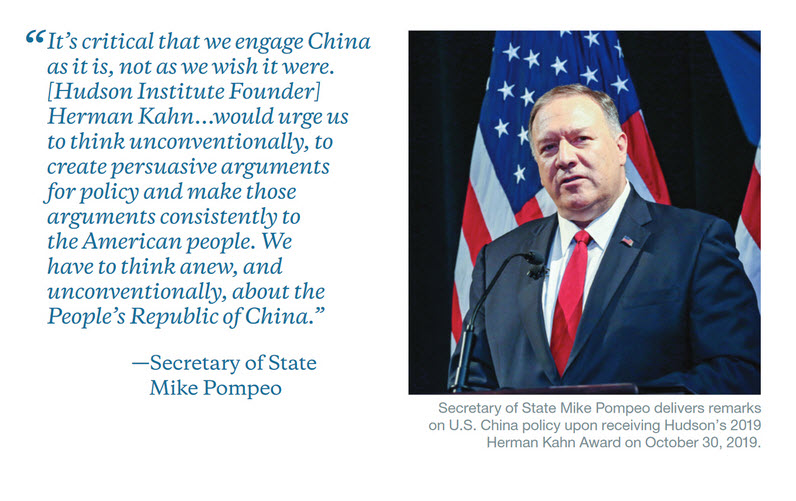
Over the years, Hudson’s efforts have been sustained by huge donations from TECRO.
The Hudson Institute does not disclose the exact donations any sources give, but their annual reports show that TECRO has been on the highest tier of donors ($100,000+) every year since they began divulging their sponsors in 2015. In February, Hudson Senior Fellow Thomas J. Duesterberg wrote an op-ed for Forbes entitled “The Economic Case for Prioritizing a U.S.-Taiwan Free Trade Agreement,” in which he extolled Taiwan’s economy as modern and dynamic and portrayed securing closer economic ties with it as a no-brainer. Hudson employees have also traveled to Taiwan to meet and hold events with leading foreign ministry officials there.
The Hudson Institute also recently partnered with the more liberal Center for American Progress (CAP) to host an event with Taiwanese President Tsai Ing-wen, who took the opportunity to make a great number of inflammatory statements about the “ever more challenging threats to free and democratic societies” China poses; applaud the U.S.’ actions on Hong Kong; and talk about how Taiwan honors and celebrates those who died at the Tiananmen Square massacre. TECRO gave the CAP between $50,000 and $100,000 last year.
The Center for Strategic and International Studies (CSIS)
It is the Center for Strategic and International Studies (CSIS), however, that appears to receive the most Taiwanese money.
According to its donor list, Taiwan gives as much money to it as the United States does — at least $500,000 last year alone.
Yet all of the Taiwanese government money is put into CSIS’s regional studies (i.e., Asia) program. Like Hudson employees, the CSIS calls for a free trade agreement with Taiwan and has lavished praise on the nation for its approach to tackling disinformation, describing it as a “thriving democracy and a cultural powerhouse.”
Although acknowledging that the reports were paid for by TECRO, CSIS insists that “all opinions expressed herein should be understood to be solely those of the authors and are not influenced in any way by any donation.”
In December, the CSIS also held a debatesuggesting that “[w]ithin the next five years, China will use significant military force against a country on its periphery,” exploring what the U.S. response to such an action should be.
Like the Atlantic Council, the CSIS organization is stacked with senior officials from the national security state. Its president and CEO is former Deputy Secretary of Defense John Hamre, while Henry Kissinger — former secretary of state and the architect of the Vietnam War — also serves on its council.
The Taiwan Foundation for Democracy (TFD)
The CSIS accepts money from the Global Taiwan Institute and the Taiwan Foundation for Democracy (TFD) as well. The former is a rather shadowy pro-Taiwanese group that appears not to disclose its funding sources.
The latter is a government-funded organization headed by former Taiwanese President You Si-kun.
Every year, the TFD publishes a human rights report on China, the latest of which claims that “the Chinese Communist Party knows no bounds when it comes to committing serious human rights violations” — accusing it of “taking the initiative” in “promoting a new Cold War over the issue of human rights” and trying to “replace the universal standing of human rights values around the world.”
Ultimately, the report concludes, China “constitutes a major challenge to democracy and freedom in the world.”
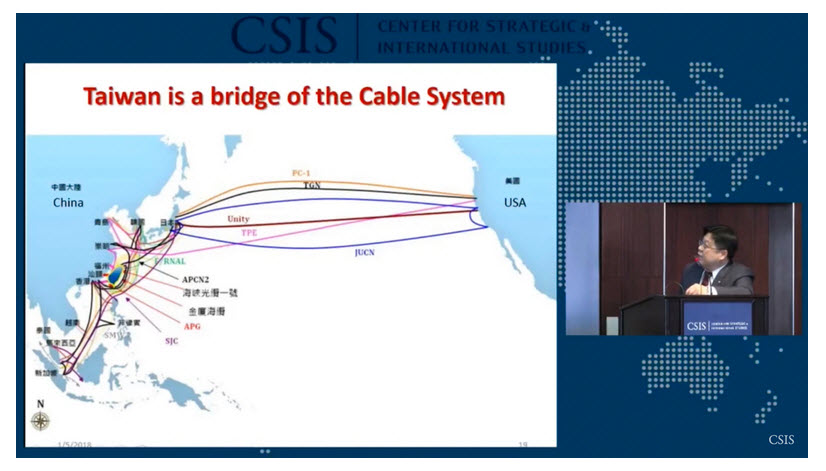
Joseph Hwang of The War College in Taiwan speaks at a CSIS about how Taiwan acts a buffer to protect US data infrastructure from China
The Victims of Communism Memorial Foundation
The TFD has also been a major funder of the Victims of Communism Memorial Foundation, a far-right pressure group that insists that Communism has killed over 100 million people worldwide.
Last year, the Victims of Communism Memorial Foundation added all global COVID-19 fatalities to the list of Communist-caused deaths on the basis that the virus started in China.
The Foundation also employs Adrian Zenz, a German evangelical theologian who is the unlikely source of many of the most controversial and contested claims about Chinese repression in Xinjiang province.
Other funded anti-China Think-Tanks
In the past 12 months, TECRO has also donated six-figure sums to many other prominent think tanks, including…
-
-
- The German Marshall Fund of the United States,
- The Center for a New American Security,
- The Carnegie Endowment for International Peace.
-
MintPress reached out to a number of these think tanks for comment but has not received any response.
“It would be naive to believe that Taiwan’s funding of think tanks is not pushing them to take pro-Taiwan or anti-China positions,” Ben Freeman, the director of the Foreign Influence Transparency Initiative at the Center for International Policy, told MintPress, adding:
After all, why would Taiwan keep funding think tanks that are critical of Taiwan? There’s a Darwinian element to foreign funding of think tanks that pushes foreign government funding to think tanks that write what that foreign government wants them to write. Taiwan is no exception to this rule.”
TECRO is not just sponsoring American think tanks, however.
the Australian Strategic Policy Institute (ASPI)
It has also given funds to the Australian Strategic Policy Institute (ASPI), a hawkish and controversial group described as “the think tank behind Australia’s changing view of China.” The country’s former ambassador in Beijing described ASPI as “the architect of the China threat theory in Australia” while Senator Kim Carr of Victoria denounced them as working hand-in-hand with Washington to push “a new Cold War with China.”
ASPI was behind Twitter’s decision last year to purge more than 170,000 accounts sympathetic to Beijing from its platform.
“We must be ready to fight our corner as Taiwan tensions rise,” ASPI wrote in January, having previously castigated the West for being “no longer willing to defend Taiwan.”
Who is behind all this money, ultimately?
ASPI — like Brookings, the Atlantic Council and others — are directly funded by weapons manufacturers, all of whom also have a direct interest in promoting more wars around the world.
Thus, if the public is not careful, certain special interests might be helping move the United States towards yet another international conflict.
While the situation outlined above is concerning enough, the Foreign Influence Transparency Initiative’s research has shown that around one-third of think tanks still do not provide any information whatsoever about their funding, and very few are completely open about their finances.
Freeman maintains that, while there is nothing inherently wrong with foreign governments funding Western think tanks, the lack of transparency is seriously problematic, explaining:
This raises a lot of questions about the work they’re doing. Are their secret funders saying what the think tank can do in a pay-for-play scheme? Are the funders buying the think tanks silence on sensitive issues? Without knowing the think tank’s funders, policymakers and the public have no idea if the think tank’s work is objective research or simply the talking points of a foreign government.”
Freeman’s study of the Taiwanese lobby found that seven organizations registered as Taiwan’s foreign agents in the U.S.
Those organizations, in turn, contacted 476 Members of Congress (including almost 90% of the House), as well as five congressional committees.
House Speaker Nancy Pelosi was their most frequent contact, the Californian being contacted 34 times by Taiwanese agents. Pelosi has been a great supporter of Taiwanese nationalists, successfully promoting pro-Taiwan legislation and proudly announcing that the U.S. “stands with Taiwan.”
Foreign agents working on behalf of Taiwan also made 143 political contributions to U.S. politicians, with former Alabama Senator Doug Jones the lead recipient (Pelosi was third).
Losing China, regaining Taiwan?
The reports listed above understand the dispute as purely a matter of Chinese belligerence against Taiwan and certainly do not consider U.S. military actions in the South China Sea as aggressive in themselves.
That is because the world of think tanks and war planners sees the United States as owning the planet.
America has the right to go and do anything that it desires anywhere on the globe at any time.
To this day, U.S. planners bemoan the “loss of China” in 1949 (a phrase that presupposes the United States owned the country).
After a long and bloody Second World War, Communist resistance forces under Mao Tse-tung managed to both expel the Japanese occupation and overcome the U.S.-backed Kuomintang (nationalist) force led by Chang Kai-shek. The United States actually invaded China in 1945, with 50,000 troops working with the Kuomintang and even Japanese forces in an attempt to suppress the Communists. However, by 1949, Mao’s army was victorious; the United States evacuated and Chang Kai-shek retreated to Taiwan.
The Kuomintang ruled the island for 40 years as a one-party state and remains one of the two major political groups to this day.
The war between the Communists and the Kuomintang never formally ended, and Taiwan has now lived through 70 years of estrangement from the mainland. Polls show a majority of Taiwanese now favor full independence, although a large majority still personally identify as Chinese.
While many Taiwanese welcome an increased U.S. presence in the region, Beijing certainly does not.
American military is getting ready for a war
In 2012, President Barack Obama announced the U.S.’ new “Pivot to Asia” strategy, moving forces from the Middle East towards China. Today, over 400 American military bases encircle China.
In recent months, the United States has also taken a number of provocative military actions on China’s doorstep.
In July, it conducted naval exercises in the South China Sea, with warships and naval aircraft spotted just 41 nautical miles from the coastal megacity of Shanghai, intent on probing China’s coastal defenses.
And in December, it flew nuclear bombers over Chinese vessels close to Hainan Island.
Earlier this year, the head of Strategic Command made his intentions clear, stating that there was a “very real possibility” of war against China over a regional conflict like Taiwan.
China, for its part, has also increased its forces in the region, carrying out military exercises and staking claims to a number of disputed islands.
A new Director of National Intelligence (DNI) report notes that China is the U.S.’ “unparalleled priority,” claiming that Beijing is making a “push for global power.” “We expect that friction will grow as Beijing steps up attempts to portray Taipei as internationally isolated and dependent on the mainland for economic prosperity, and as China continues to increase military activity around the island,” it concludes.
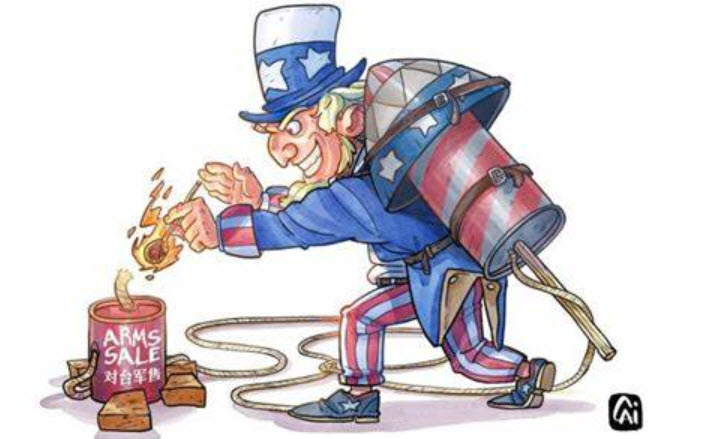
In an effort to stop this, Washington has recruited allies into the conflict. Australian media are reporting that their military is currently readying for war in an effort to force China to back down, while in late April 2021 President Joe Biden met with Japanese Prime Minister Yoshihide Suga to shore up a united front against Beijing vis-a-vis Taiwan.
In February, the Atlantic Council penned an anonymous 26,000-word report advising Biden to draw a number of red lines around China, beyond which a response — presumably military — is necessary. These included any military action or even a cyber attack against Taiwan. Any backing down from this stance, the council states, would result in national “humiliation” for the United States.
American fantasy dreams
Perhaps most notably, however, the report also envisages what a successful American China policy would look like by 2050:
[T]he United States and its major allies continue to dominate the regional and global balance of power across all the major indices of power;… [and head of state Xi Jinping] has been replaced by a more moderate party leadership; and … the Chinese people themselves have come to question and challenge the Communist Party’s century-long proposition that China’s ancient civilization is forever destined to an authoritarian future.”
In other words, that China has been broken and that some sort of regime change has occurred.
Forked tongue speak
Throughout all this, the United States has been careful to stress that it still does not recognize Taiwan and that their relationship is entirely “unofficial,” despite claiming that its commitment to the island remains “rock solid.”
Indeed, only 14 countries formally recognize Taiwan, the largest and most powerful of which is Paraguay.
Along with a military conflict brewing, Washington has also been prosecuting an information and trade war against China on the world stage.
- Attempts to block the rise of major Chinese companies like Huawei, TikTok and Xiaomi are examples of this.
- Others in Washington have advised the Pentagon to carry out an under-the-table culture war against Beijing.
- This would include commissioning “Taiwanese Tom Clancy” novels that would “weaponize” China’s one-child policy against it.
- And, bombarding citizens with stories about how their only children will die in a war over Taiwan.
Republicans and Democrats constantly accuse each other of being in President Xi’s pocket, attempting to outdo each other in their jingoistic fervor.
Last year, in 2020, Florida Senator Rick Scottwent so far as to announce that every Chinese national in the U.S. was a Communist spy and should be treated with extreme suspicion.
As a result, the American public’s view of China has crashed to an all-time low.
Only three years ago, the majority of Americans held a positive opinion of China. But today, that number is only 20%. Asian-Americans of all backgrounds have reported a rise in hate crimes against them.
Cash rules everything around me
How much of the United States’ aggressive stance towards China can be attributed to Taiwanese money influencing politics?
It is difficult to say.
Certainly, the United States has its own policy goals in East Asia outside of Taiwan.
But Freeman believes that the answer is not zero. The Taiwan lobby “absolutely has an impact on U.S. foreign policy,” he said, adding:
At one level, it creates an echo-chamber in D.C. that makes it taboo to question U.S. military ties with Taiwan. While I, personally, think there are good strategic reasons for the U.S. to support this democratic ally — and it’s clearly in Taiwan’s interest to keep the U.S. fully entangled in their security — it’s troubling that the D.C. policy community can’t have an honest conversation about what U.S. interests are. But, Taiwan’s lobby in D.C. and their funding of think tanks both work to stifle this conversation and, frankly, they’ve been highly effective.”
Other national lobbies affect U.S. policy.
The Cuban lobby helps ensure that the American stance towards its southern neighbor remains as antagonistic as possible.
Meanwhile, the Israel lobby helps ensure continuing U.S. support for Israeli actions in the Middle East.
Yet more ominously with Taiwan, its representatives are helping push the U.S. closer towards a confrontation with a nuclear power.
While Taiwanese money appears to have convinced many in Washington, it is doubtful that ordinary Americans will be willing to risk a war over an island barely larger than Hawaii, only 80 miles off the coast of mainland China.
You would think…
But now, I’m not so sure…
US Seeks South China Sea Conflict
Despite hopes by some that with Joe Biden a new US foreign policy will follow – US Secretary of State Antony Blinken has reaffirmed Washington’s committment to seeking conflict in the South China Sea under the guise of “standing with Southeast Asian claimants.”
Secretary Blinken pledged to stand with Southeast Asian claimants in the face of PRC pressure,” it said, referring to the People’s Republic of China.China claims almost all of the energy-rich South China Sea, which is also a major trade route. The Philippines, Brunei, Vietnam, Malaysia and Taiwan have overlapping claims.The United States has accused China of taking advantage of the distraction of the coronavirus pandemic to advance its presence in the South China Sea.
The US announcement confirms that a confrontational posture toward China will continue regardless of who occupies the White House – as US tensions with China are rooted in unelected Western special interests and their desire to remove China as a competitor and potential usurper in what US policy papers themselves call “US primacy in Asia.”
US Primacy in Asia
One such paper titled, “Revising US Grand Strategy Toward China,”…
…published by the Council on Foreign Relations in 2015…
…not only spelled out the US desire to maintain that primacy in Asia vis-a-vis China…
… but also how it would use overlapping claims in the South China Sea as a pretext to justify….
…an expanded military presence in the region and as a common cause to pressure China’s neighbors into a united front against Beijing.
The paper would note specific US goals of militarizing Southeast Asia and integrating the region into a common US-led defense architecture against China.
It is a policy built upon the US “pivot to Asia” unveiled as early as 2011 and a policy that has been built upon in turn during the last four years under the Trump administration – demonstrating the continuity of agenda that permeates US foreign policy.
Turning Disputes into Conflict
Maritime disputes are common throughout the world – even in the West.
Just at the end of last year, the Guardian in an article titled, “Four navy ships to help protect fishing waters in case of no-deal Brexit,” would report:
Four Royal Navy patrol ships will be ready from 1 January to help the UK protect its fishing waters in the event of a no-deal Brexit, in a deployment evoking memories of the “cod wars” in the 1970s. The 80-metre-long armed vessels would have the power to halt, inspect and impound all EU fishing boats operating within the UK’s exclusive economic zone (EEZ), which can extend 200 miles from shore.
In terms of such disputes, the waters of the South China Sea are no exception.
Not only does China have overlapping claims with the nations mentioned in the Reuters article – each nation listed has overlapping claims with one another.
This results in sporadic disputes between all of these nations – occasionally resulting in the seizing of vessels and the temporary detaining of boat crews.
However – these disputes are regularly settled through bilateral methods – including disputes between Southeast Asian nations and China itself.
A high-profile example of this unfolded in 2015 where a US-led legal case was brought to the Hague on behalf of the Philippines regarding Chinese claims over the South China Sea. While the Hague ruled in the Philippines’ favor – Manila declined to use the ruling as leverage against Beijing or to seek Washington’s assistance – and instead pursued bilateral talks with Beijing directly on its own. It is a case that demonstrates the desire by Washington to escalate what are ordinary maritime disputes, into a regional or even international crisis – not unlike the US’ strategy in the Middle East which it uses to justify its perpetual military occupation there.
More recently the issue of the South China Sea has come up at ASEAN Summits.
Al Jazeera in its article, “ASEAN summit: South China Sea, coronavirus pandemic cast a shadow,” would cite Malaysia’s take on the issue, noting:
“The South China Sea issue must be managed and resolved in a rational manner,” Malaysia’s Foreign Minister Hishammuddin Hussein told the meeting. “We must all refrain from undertaking activities that would complicate matters in the South China Sea. We have to look at all avenues, all approaches to ensure our region is not complicated further by other powers.”
While the US poses a champion for Southeast Asia – it is clear that its efforts are unwelcome and viewed instead as a source of instability – not a path toward resolution.
It is almost certain that it is Washington the Malaysian foreign minister was referring to when he mentioned “other powers.”
Just as the US nominated itself as protector of European “energy security” in its bid to obstruct the Russian-German Nord Stream 2 pipeline – the US has inserted itself into relatively routine maritime disputes in the South China Sea – not to “stand with” the nations of the region, but to serve as an excuse to impose its “primacy” over them.
The nations of Southeast Asia count China among their largest trade partners, sources of tourism, and for several – a key military and infrastructure partner.
The prospect of a regionally destabilizing conflict originating over long-standing disputes in the South China Sea benefits no one actually located in Asia – and only serves the interests of those beyond Asia seeking to divide and reassert their rule over it.
Who are these people?
Who are these Taiwan Oligarchs that want to start World War III? Most are old men. The youngest is in their 60’s. Most are in their mid to late 70’s and much older. What are they trying to do, and why? Are they so fixated in what happened fifty years ago that they cannot see what is going on right now, and what a bright future lies ahead for them?
MM is providing their names right here for you all to see.
Yeah. I wonder how much of a shame it would be for these people to suddenly stop provoking a war beacause of other issues that they need to deal with.
Conclusion to all of this
The governments do not want wars or conflict in the South China Sea, but the oligarchs do.
They are pushing, and pushing, and pushing for a war.
And “red lines” have been established.
- For China to invade Taiwan.
- For China to attack American cities.
- For Taiwan to get involved with the United States.
And the wealthy oligarchy are pushing these limits.
And this is what is going on right now.
How successful will the oligarchy be? It’s a matter up to the government leadership.
A final word…
It’s propaganda that is pushing the world towards world war III. And this propaganda is very devious and very destructive.
The following is from the US defense department. It shows the nuclear delivery systems of American, China and Russia compared. Imagine that, the only nuclear delivery systems that America has according to the media are airborne!
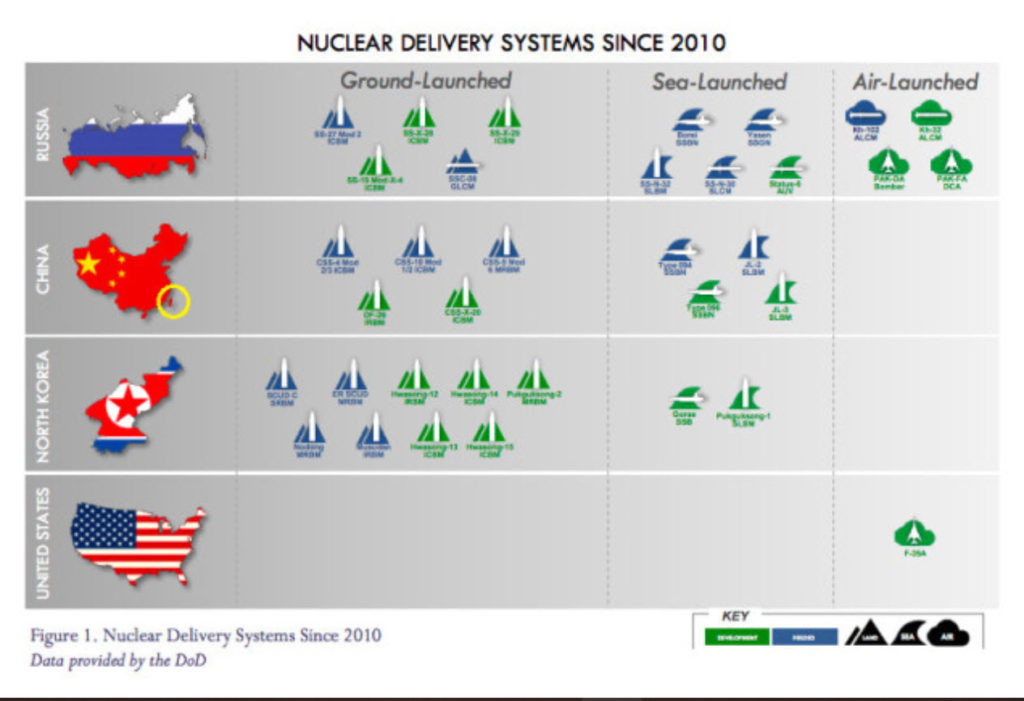
Do you believe it?
You shouldn’t. It’s false; it’s a lie.
But many do believe it. And that why there is an inherent danger in all these oligarchs pushing the world towards world war III.
Do you want more?
I have more posts in my China Index here…
USA / China.
Articles & Links
Master Index.
You’ll not find any big banners or popups here talking about cookies and privacy notices. There are no ads on this site (aside from the hosting ads – a necessary evil). Functionally and fundamentally, I just don’t make money off of this blog. It is NOT monetized. Finally, I don’t track you because I just don’t care to.
- You can start reading the articles by going HERE.
- You can visit the Index Page HERE to explore by article subject.
- You can also ask the author some questions. You can go HERE to find out how to go about this.
- You can find out more about the author HERE.
- If you have concerns or complaints, you can go HERE.
- If you want to make a donation, you can go HERE.

